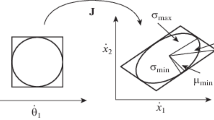Abstract
A two-stage method for organizing control of a robot with parallel kinematics is proposed. The method involves the transfer of all complex resource-intensive computational procedures to the stage of the trajectory formation. During the operational control of the robot’s movement, a ready-made trajectory is used, recorded as points in the input coordinate space of the mechanism. Method application allows avoiding multiple solutions of the forward and inverse kinematics during the robot movement, significantly increasing the performance of the control system. Experimental verification of the method was carried out using the planar 3-RPR mechanism as an example.
Access this chapter
Tax calculation will be finalised at checkout
Purchases are for personal use only
Similar content being viewed by others
References
Heydarzadeh, M., Karbasizadeh, N., Tale Masouleh, M., Kalhor, A.: Experimental kinematic identification and position control of a 3-DOF decoupled parallel robot. Proc. Inst. Mech. Eng. Part C: J. Mech. Eng. Sci. 233(5), 1841–1855 (2019)
Lintao, W., Ji, L., Lei, Z.: Kinematic analysis and speed control of 3SPS-1S parallel mechanism for end actuator of segment erector. Lecture Notes in Computer Science (Including Subseries Lecture Notes in Artificial Intelligence and Lecture Notes in Bioinformatics), LNAI, vol. 11745 (2019)
Liu, K., Chen, Y., Wu, Y., Xu, J., Wang, Y., Ge, Z.: Rotation control of a 3-DOF parallel mechanism driven by pneumatic muscle actuators. Trans. Nanjing Univ. Aeronaut. Astronaut. 36(2), 330–338 (2019)
Abadi, B.N.R., Farid, M., Mahzoon, M.: Redundancy resolution and control of a novel spatial parallel mechanism with kinematic redundancy. Mech. Mach. Theory 133, 112–126 (2019)
Shen, G., Li, G., Zang, W., Li, X., Tang, Y.: Modal space feedforward control for electro-hydraulic parallel mechanism. IEEE Access 7, 39751–39761 (2019)
Tang, J., Cao, D., Yu, T.: Decentralized vibration control of a voice coil motor-based stewart parallel mechanism: Simulation and experiments. Proc. Inst. Mech. Eng. Part C: J. Mech. Eng. Sci. 233(1), 132–145 (2019)
Wang, R., Lü, J., Zhong, S., Qu, H., Wang, J., Chen, X.: Attitude control algorithm for a 2-DOF parallel vector propulsion mechanism on AUV. Harbin Gongye Daxue Xuebao/J. Harbin Inst. Technol. 51(4), 1–5 (2019)
Zhao, L., Cheng, H., Zhang, J., Xia, Y.: Angle attitude control for a 2-DOF parallel mechanism of PMAs using tracking differentiators. IEEE Trans. Industr. Electron. 66(11), 8659–8669 (2019)
Zheng, S., Gao, C., Niu, X., Cong, D., Han, J.: The applications of compliant motion control technique on 6-DOF hydraulic parallel mechanism. IEEE Access 7, 90094–90105 (2019)
Joumah, A.A., Albitar, C.: Design optimization of 6-RUS parallel manipulator using hybrid algorithm. Int. J. Inf. Technol. Comput. Sci. (IJITCS) 10(2), 83–95 (2018)
Mohammed, R.H., Elnaghi, B.E., Bendary, F.A., Elserfi, K.: Trajectory tracking control and robustness analysis of a robotic manipulator using advanced control techniques. Int. J. Eng. Manuf. (IJEM) 8(6), 42–54 (2018)
Tayebihaghighi, S., Piltan, F., Kim, J.-M.: Control of an uncertain robot manipulator using an observation-based modified fuzzy sliding mode controller. Int. J. Intell. Syst. Appl. (IJISA) 10(3), 41–49 (2018)
Sahraoui, M., Khelfi, M.F., Salem, M.: Sequential adaptive fuzzy inference system based intelligent control of robot manipulators. Int. J. Intell. Syst. Appl. (IJISA) 6(11), 49–56 (2014)
Su, T., Cheng, L., Wang, Y., Liang, X., Zheng, J., Zhang, H.: Time-optimal trajectory planning for delta robot based on quintic pythagorean-hodograph curves. IEEE Access 6, 28530–28539 (2018)
Farajtabar, M., Daniali, H., Varedi, S.: Pick and place trajectory planning of planar 3-RRR parallel manipulator in the presence of joint clearance. Robotica 35(2), 241–253 (2017)
Rybak, L., Khalapyan, S., Kholoshevskaya, L., Malyshev, D.: Planning the optimal trajectory of the robot-machine parallel structure. In: AIP Conference Proceedings, vol. 2029, pp. 1–6 (2018). 020066
Khalapyan, S., Rybak, L., Malyshev, D., Kuzmina, V.: Synthesis of parallel robots optimal motion trajectory planning algorithms. In: IX International Conference on Optimization and Applications, OPTIMA 2018, pp. 311–324 (2018)
Khalapyan, S.Y., Glushchenko, A.I., Rybak, L.A., Gaponenko, E.V., Malyshev, D.I.: Intelligent computing based on neural network model in problems of kinematics and control of parallel robot. In: 3rd Russian-Pacific Conference on Computer Technology and Applications (RPC), pp. 1–5 (2018)
Husty, M.L.: An algorithm for solving the direct kinematic of StewartGough-type platforms. Mech. Mach. Theory 31(4), 365–380 (1996)
Rybak, L.A., Khalapyan, S.Y., Gaponenko, E.V.: Issues of planning trajectory of parallel robots taking into account zones of singularity. In: IOP Conference Series: Materials Science and Engineering, vol. 327, pp. 1–8 (2018). 042092
Acknowledgements
This work was supported by the Russian Science Foundation, the agreement number 16-19-00148.
Author information
Authors and Affiliations
Corresponding author
Editor information
Editors and Affiliations
Rights and permissions
Copyright information
© 2020 The Editor(s) (if applicable) and The Author(s), under exclusive license to Springer Nature Switzerland AG
About this paper
Cite this paper
Khalapyan, S., Rybak, L., Malyshev, D. (2020). Two-Stage Method for Controlling the Movement of a Parallel Robot Based on a Planar Three-Revolute-Prismatic-Revolute Mechanism. In: Hu, Z., Petoukhov, S., He, M. (eds) Advances in Artificial Systems for Medicine and Education III. AIMEE 2019. Advances in Intelligent Systems and Computing, vol 1126. Springer, Cham. https://doi.org/10.1007/978-3-030-39162-1_34
Download citation
DOI: https://doi.org/10.1007/978-3-030-39162-1_34
Published:
Publisher Name: Springer, Cham
Print ISBN: 978-3-030-39161-4
Online ISBN: 978-3-030-39162-1
eBook Packages: Intelligent Technologies and RoboticsIntelligent Technologies and Robotics (R0)




